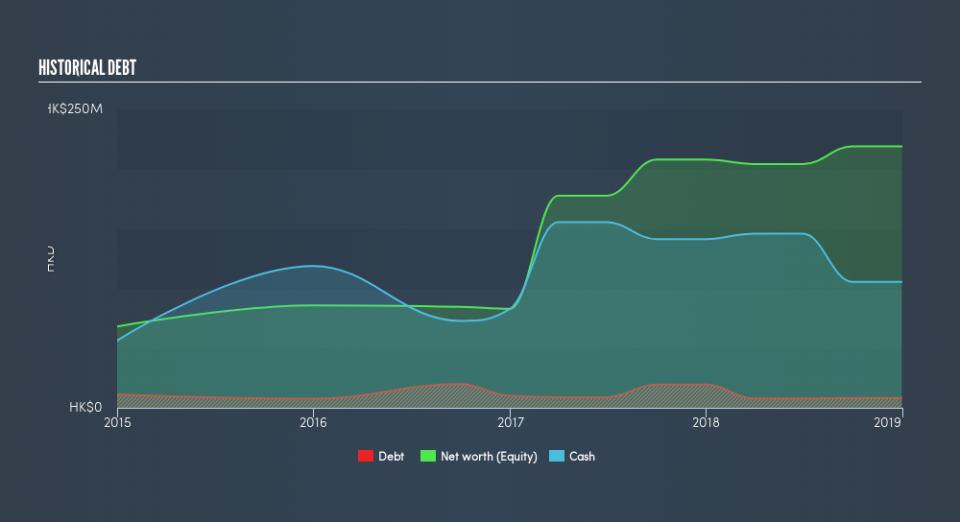We Think G M Holdings (HKG:6038) Can Stay On Top Of Its Debt

The external fund manager backed by Berkshire Hathaway's Charlie Munger, Li Lu, makes no bones about it when he says 'The biggest investment risk is not the volatility of prices, but whether you will suffer a permanent loss of capital.' So it seems the smart money knows that debt - which is usually involved in bankruptcies - is a very important factor, when you assess how risky a company is. We note that G & M Holdings Limited (HKG:6038) does have debt on its balance sheet. But the real question is whether this debt is making the company risky.
Why Does Debt Bring Risk?
Generally speaking, debt only becomes a real problem when a company can't easily pay it off, either by raising capital or with its own cash flow. If things get really bad, the lenders can take control of the business. However, a more frequent (but still costly) occurrence is where a company must issue shares at bargain-basement prices, permanently diluting shareholders, just to shore up its balance sheet. Of course, plenty of companies use debt to fund growth, without any negative consequences. When we think about a company's use of debt, we first look at cash and debt together.
View our latest analysis for G & M Holdings
How Much Debt Does G & M Holdings Carry?
You can click the graphic below for the historical numbers, but it shows that G & M Holdings had HK$8.23m of debt in December 2018, down from HK$19.5m, one year before. But it also has HK$105.5m in cash to offset that, meaning it has HK$97.2m net cash.
A Look At G & M Holdings's Liabilities
According to the balance sheet data, G & M Holdings had liabilities of HK$83.5m due within 12 months, but no longer term liabilities. Offsetting this, it had HK$105.5m in cash and HK$187.5m in receivables that were due within 12 months. So it actually has HK$209.5m more liquid assets than total liabilities.
This surplus liquidity suggests that G & M Holdings's balance sheet could take a hit just as well as Homer Simpson's head can take a punch. With this in mind one could posit that its balance sheet is as strong as beautiful a rare rhino. Simply put, the fact that G & M Holdings has more cash than debt is arguably a good indication that it can manage its debt safely.
In fact G & M Holdings's saving grace is its low debt levels, because its EBIT has tanked 35% in the last twelve months. When a company sees its earnings tank, it can sometimes find its relationships with its lenders turn sour. There's no doubt that we learn most about debt from the balance sheet. But it is G & M Holdings's earnings that will influence how the balance sheet holds up in the future. So if you're keen to discover more about its earnings, it might be worth checking out this graph of its long term earnings trend.
Finally, a business needs free cash flow to pay off debt; accounting profits just don't cut it. While G & M Holdings has net cash on its balance sheet, it's still worth taking a look at its ability to convert earnings before interest and tax (EBIT) to free cash flow, to help us understand how quickly it is building (or eroding) that cash balance. Considering the last three years, G & M Holdings actually recorded a cash outflow, overall. Debt is far more risky for companies with unreliable free cash flow, so shareholders should be hoping that the past expenditure will produce free cash flow in the future.
Summing up
While it is always sensible to investigate a company's debt, in this case G & M Holdings has HK$97m in net cash and a strong balance sheet. So we are not troubled with G & M Holdings's debt use. Another positive for shareholders is that it pays dividends. So if you like receiving those dividend payments, check G & M Holdings's dividend history, without delay!
At the end of the day, it's often better to focus on companies that are free from net debt. You can access our special list of such companies (all with a track record of profit growth). It's free.
We aim to bring you long-term focused research analysis driven by fundamental data. Note that our analysis may not factor in the latest price-sensitive company announcements or qualitative material.
If you spot an error that warrants correction, please contact the editor at editorial-team@simplywallst.com. This article by Simply Wall St is general in nature. It does not constitute a recommendation to buy or sell any stock, and does not take account of your objectives, or your financial situation. Simply Wall St has no position in the stocks mentioned. Thank you for reading.


